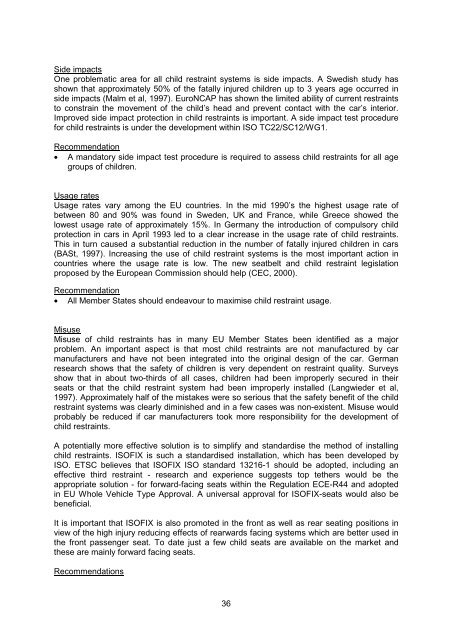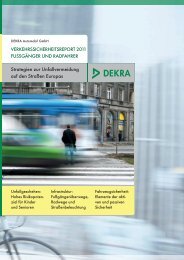PRIORITIES FOR EU MOTOR VEHICLE SAFETY DESIGN
priorities for eu motor vehicle safety design - ETSC
priorities for eu motor vehicle safety design - ETSC
Create successful ePaper yourself
Turn your PDF publications into a flip-book with our unique Google optimized e-Paper software.
Side impacts<br />
One problematic area for all child restraint systems is side impacts. A Swedish study has<br />
shown that approximately 50% of the fatally injured children up to 3 years age occurred in<br />
side impacts (Malm et al, 1997). EuroNCAP has shown the limited ability of current restraints<br />
to constrain the movement of the child’s head and prevent contact with the car’s interior.<br />
Improved side impact protection in child restraints is important. A side impact test procedure<br />
for child restraints is under the development within ISO TC22/SC12/WG1.<br />
Recommendation<br />
• A mandatory side impact test procedure is required to assess child restraints for all age<br />
groups of children.<br />
Usage rates<br />
Usage rates vary among the <strong>EU</strong> countries. In the mid 1990’s the highest usage rate of<br />
between 80 and 90% was found in Sweden, UK and France, while Greece showed the<br />
lowest usage rate of approximately 15%. In Germany the introduction of compulsory child<br />
protection in cars in April 1993 led to a clear increase in the usage rate of child restraints.<br />
This in turn caused a substantial reduction in the number of fatally injured children in cars<br />
(BASt, 1997). Increasing the use of child restraint systems is the most important action in<br />
countries where the usage rate is low. The new seatbelt and child restraint legislation<br />
proposed by the European Commission should help (CEC, 2000).<br />
Recommendation<br />
• All Member States should endeavour to maximise child restraint usage.<br />
Misuse<br />
Misuse of child restraints has in many <strong>EU</strong> Member States been identified as a major<br />
problem. An important aspect is that most child restraints are not manufactured by car<br />
manufacturers and have not been integrated into the original design of the car. German<br />
research shows that the safety of children is very dependent on restraint quality. Surveys<br />
show that in about two-thirds of all cases, children had been improperly secured in their<br />
seats or that the child restraint system had been improperly installed (Langwieder et al,<br />
1997). Approximately half of the mistakes were so serious that the safety benefit of the child<br />
restraint systems was clearly diminished and in a few cases was non-existent. Misuse would<br />
probably be reduced if car manufacturers took more responsibility for the development of<br />
child restraints.<br />
A potentially more effective solution is to simplify and standardise the method of installing<br />
child restraints. ISOFIX is such a standardised installation, which has been developed by<br />
ISO. ETSC believes that ISOFIX ISO standard 13216-1 should be adopted, including an<br />
effective third restraint - research and experience suggests top tethers would be the<br />
appropriate solution - for forward-facing seats within the Regulation ECE-R44 and adopted<br />
in <strong>EU</strong> Whole Vehicle Type Approval. A universal approval for ISOFIX-seats would also be<br />
beneficial.<br />
It is important that ISOFIX is also promoted in the front as well as rear seating positions in<br />
view of the high injury reducing effects of rearwards facing systems which are better used in<br />
the front passenger seat. To date just a few child seats are available on the market and<br />
these are mainly forward facing seats.<br />
Recommendations<br />
36



